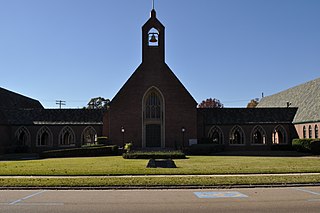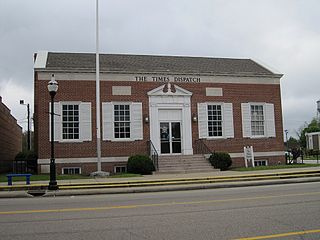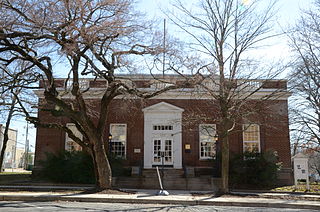
Ashley County is a rural South Arkansas county with a culture, economy, and history based on timber and agriculture. Created as Arkansas's 52nd county on November 30, 1848, Ashley County has seven incorporated municipalities, including Hamburg, the county seat and Crossett, the most populous city. The county is also the site of numerous unincorporated communities and ghost towns. The county is named for Chester Ashley, a prominent lawyer in the Arkansas Territory and U.S. senator from the state from 1844 to 1848.

Crossett is the largest city in Ashley County, Arkansas, United States, with a population of 5,507, according to 2010 Census Bureau estimates. Combined with North Crossett and West Crossett, the population is 10,752. Crossett was incorporated in 1903.

The Arkansas Post was the first European settlement in the Mississippi Alluvial Plain and present-day Arkansas. Henri de Tonti established it in 1686 as a French trading post on the lower Arkansas River, where the French and Spanish traded with the Quapaw people for years.

Historic Washington State Park is a 101-acre (41 ha) Arkansas state park in Hemsptead County, Arkansas in the United States. The museum village contains a collection of pioneer artifacts from the town of Washington, Arkansas, which is a former pioneer settlement along the Southwest Trail. Walking interpretive tours are available throughout the 54 buildings. Washington served as a major trading point along the Southwest Trail, evolving into the Hempstead county seat and later the capital of Arkansas from 1863 to 1865 when Little Rock was threatened during the Civil War. The original plat of Washington was added to the National Register of Historic Places in 1972 as the Washington Historic District.

Davidsonville Historic State Park is a 163-acre (66 ha) Arkansas state park in Randolph County, Arkansas in the United States. Situated on a border between The Ozarks and the Arkansas Delta, the park preserves the remains of the abandoned frontier town of Davidsonville. The town was one of Arkansas Territory's first settlements when founded in 1815, serving as an important river port town on the Black River. The former townsite was made into a state park in 1957 and a monument was added to the National Register of Historic Places in 1974.

Crossett Municipal Auditorium is a historic auditorium building at 1100 Main Street in Crossett, Arkansas. The building was listed in the National Register of Historic Places on September 20, 2007.
Municipal Building may refer to the following places:

Arkansas Highway 133 is a designation for three state highways in South Arkansas. One route of 24.20 miles (38.95 km) runs from Louisiana Highway 142 north through Crossett to Highway 8 near Fountain Hill. A second segment runs from Highway 160 north to US Route 425 (US 425) at Lacey. A third segment begins in Rison at Highway 35 and runs north to Highway 54 south of Pine Bluff.
U.S. Highway 82 in Arkansas is a major east–west arterial highway across the state's lowest tier of counties. It enters Arkansas from Texas, concurrent with US Highway 67, at a junction with US Highway 71 on the border between Texarkana, Texas and Texarkana, Arkansas. The route leaves Arkansas on the Lake Village Bridge over the Mississippi River near Lake Village, crossing into Mississippi.
The University of Arkansas Campus Historic District is a historic district that was listed on the National Register of Historic Places on September 23, 2009. The district covers the historic core of the University of Arkansas campus, including 25 buildings.

The United States Post Office and Courthouse, also known as Texarkana U.S. Post Office and Federal Building and as Texarkana U.S. Post Office and Courthouse, is located on State Line Avenue in Texarkana, straddling the border between Arkansas and Texas. It is a courthouse of the United States District Court for the Western District of Arkansas and the United States District Court for the Eastern District of Texas.

The Grafton Post Office is a historic former post office building at 205 Main Street in Grafton, Vermont. Built in 1855 in the Greek Revival style, it was the town's post office for over 100 years, and served for a time thereafter as the local historical society museum. It was listed on the National Register of Historic Places in 2005. It is still owned by the historical society, but leased for commercial retail purposes.

The Fayetteville Historic Square, in Fayetteville, Arkansas, includes the original Fayetteville post office, the Old Bank of Fayetteville Building, the Lewis Brothers Building, the Mrs. Young Building, and the Guisinger Building. These buildings are listed in the National Register of Historic Places. There are several more recent buildings located on the Square.

John Parks Almand was an American architect who practiced in Arkansas from 1912 to 1962. Among other works, he designed the Art Deco Hot Springs Medical Arts Building, which was the tallest building in Arkansas from 1930 to 1958. Several of his works, including the Medical Arts Building and Little Rock Central High School, are listed on the National Register of Historic Places.

The Crossett Methodist Church is now known as the First Methodist Church of Crossett. It is at 500 Main St., Crossett, Arkansas, United States, and was built in 1949.

Crossett Experimental Forest is an experimental forest operated by the Southern Research Station (SRS) of the United States Forest Service in Ashley County, Arkansas. It is managed out of the SRS office in Monticello, Arkansas, with onsite facilities about 6.8 miles (10.9 km) south of Crossett, Arkansas off Arkansas Highway 133.

The Crossett Municipal Building is a historic multi-function municipal building at 307-309 Main Street in Crossett, Arkansas. The Art Deco building was designed by the firm of Trapp, Clippard & Phelps, and built in 1954 by C.W. Vollmer. Its exterior is primarily brick, with limestone trim. Prior to its construction, the municipal services of the city were scattered throughout town, and construction of this building was authorized in order to centralize them. The building was designed to house the public library in its north wing, the fire station in the south wing, and municipal offices, including the council chambers, mayor's office, and municipal court, in the center. The library moved out of its space in the 1960s, after which it was taken over by the police department.

The Kress Building is a historic commercial building at 210 West Main Street in Blytheville, Arkansas. It is a two-story concrete and steel structure, faced in brick and terra cotta. Built in 1938, it was one of the first buildings in the city to be built using steel framing, and is one of its finest Art Deco structures. The first floor areas are faced in terra cotta, while the second floor is predominantly cream-colored brick. Windows on the second floor are surrounded by ivory terra cotta incised with fluting and shell patterns.

The Old Walnut Ridge Post Office is a historic commercial building at 225 West Main Street in Walnut Ridge, Arkansas. It is a 1+1⁄2-story T-shaped brick structure, five bays wide, with a side gable roof and a full concrete basement. Its Colonial Revival features include a centered entry, flanked by Ionic pilasters and topped by a broken gabled pediment. The remaining bays are filled with nine-over-nine sash windows. The eave is plain concrete, except for a course of modillions just below the roof line. The building was designed under Louis A. Simon of the Office of the Supervising Architect and was completed in 1935. It served as a post office until 1977, and then served as the facilities of the local Times Dispatch newspaper.

The Old Post Office is a historic former post office building at 120 West Poplar Street in Rogers, Arkansas. It is a Georgian Revival single-story brick building, built in 1917 to a design by the Office of the Supervising Architect. The building served as the city's main post office until the late 1940s. It was then adapted to house the Rogers Public Library, which occupied the premises between 1963 and 1994. An example of Georgian Revival architecture, it was listed on the National Register of Historic Places in 1988 as "Rogers Post Office Building".



















